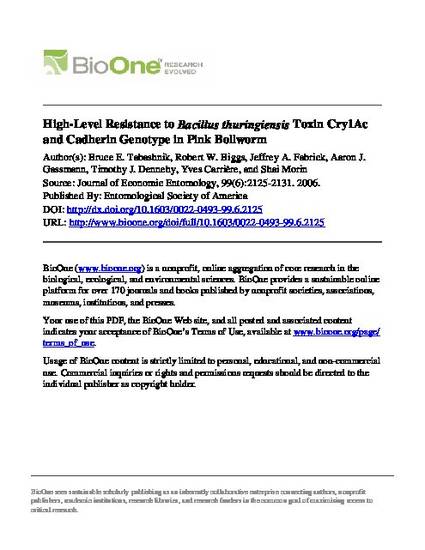
Article
High-Level Resistance to Bacillus thuringiensis Toxin Cry1Ac and Cadherin Genotype in Pink Bollworm
Journal of Economic Entomology
(2006)
Abstract
Resistance to transgenic cotton, Gossypium hirsutum L., producing Bacillus thuringiensis (Bt) toxin Cry1Ac is linked with three recessive alleles of a cadherin gene in laboratory-selected strains of pink bollworm, Pectinophora gossypiella (Saunders), a major cotton pest. Here, we analyzed a strain (MOV97-R) with a high frequency of cadherin resistance alleles, a high frequency of resistance to 10 μg of Cry1Ac per milliliter of diet, and an intermediate frequency of resistance to 1,000 μg of Cry1Ac per ml of diet. We selected two strains for increased resistance by exposing larvae from MOV97-R to diet with 1,000 μg of Cry1Ac per ml of diet. In both selected strains, two to three rounds of selection increased survival at 1,000 μg of Cry1Ac per ml of diet to at least 76%, indicating genetic variation in survival at this high concentration and yielding >4,300-fold resistance relative to a susceptible strain. Variation in cadherin genotype did not explain variation in survival at 1,000 μg of Cry1Ac per ml of diet, implying that one or more other loci affected survival at this concentration. This conclusion was confirmed with results showing that when exposure to Cry1Ac stopped, survival at 1,000 μg of Cry1Ac per ml of diet dropped substantially, but survival at 10 μg Cry1Ac per ml of diet remained close to 100% and all survivors had two cadherin resistance alleles. Although survival at 1,000 μg of Cry1Ac per ml of diet is not required for resistance to Bt cotton, understanding how genes other than cadherin confer increased survival at this high concentration may reveal novel mechanisms of resistance.
Keywords
- genetics,
- resistance,
- genetically modified crops,
- Bacillus thuringiensis,
- Pectinophora gossypiella
Disciplines
Publication Date
December, 2006
Publisher Statement
Works produced by employees of the U.S. Government as part of their official duties are not copyrighted within the U.S. The content of this document is not copyrighted.
Citation Information
Aaron J. Gassmann, Robert W. Biggs, Jeffrey A. Fabrick, Bruce E. Tabashnick, et al.. "High-Level Resistance to Bacillus thuringiensis Toxin Cry1Ac and Cadherin Genotype in Pink Bollworm" Journal of Economic Entomology Vol. 99 Iss. 6 (2006) Available at: http://works.bepress.com/aaron_gassmann/30/
